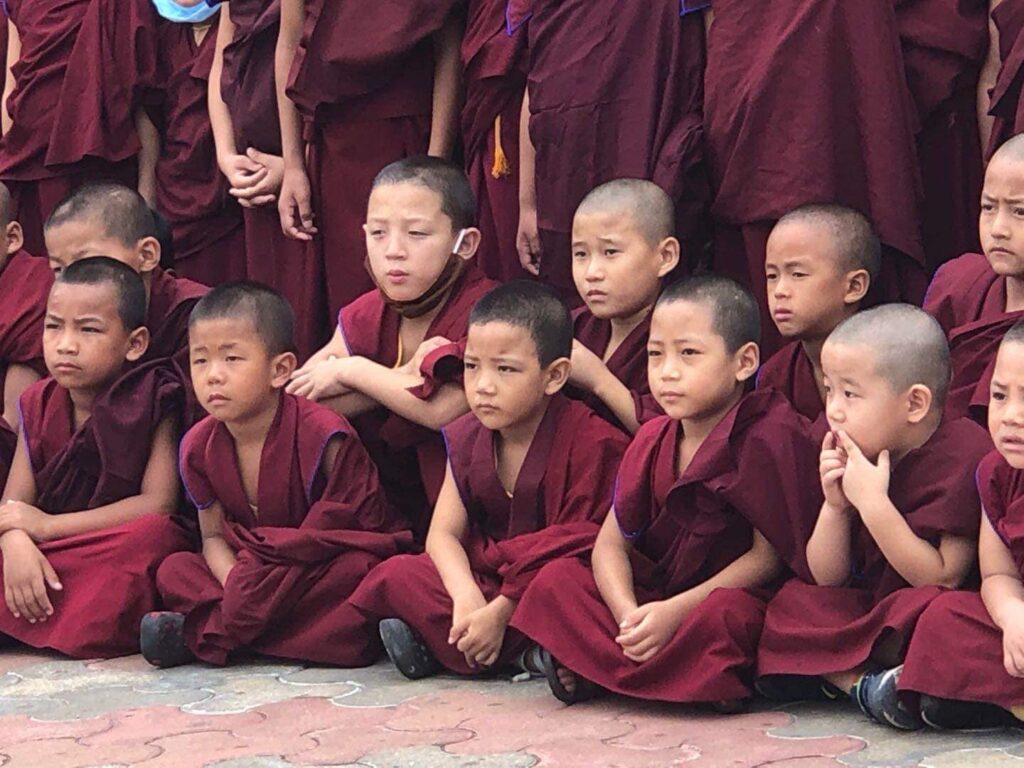SERA MONASTERY
History of Sera

Sera used to be one of the three most important monasteries of Tibet, together with Ganden and Drepung. All three monasteries were located near Lhasa, capital of Tibet and belongs to the Gelug-tradition of Tibetan Buddhism, of which the Dalai Lama and the Panchen Lama are the heads. When the Chinese occupied Tibet, Sera was largely destroyed. Sera monastery in Bylakuppe, South India (the new one), being built in 1970, is more or less an exact copy of the original, it consists of Sera Je and Sera Mey, each have their own main temple.
First the monks lived in army-tents for about 3,5 years, near what is now Sera Mey health care, the creek nearby was their water supply. The monks had to chop down all the trees, with help of the Indian government, to make open fields. Sera Je and Sera Mey monks worked together then. When the fields were ready the monks started working on it and continued to do so until recently.
The government also built one house for the monks of Sera. With this as a starting point the monks built more houses and Sera Je and Sera Mey slowly separated again. Once Sera was being set up, the monks of Drepung and Ganden went to Mundgod, because there was not enough space for all three monasteries to be together.
Monastic structure of Sera
Sera belongs to the Gelugpa-tradition of Tibetan Buddhism. Of the four schools, the Gelugpas are traditionally most scholastic and place much emphasis on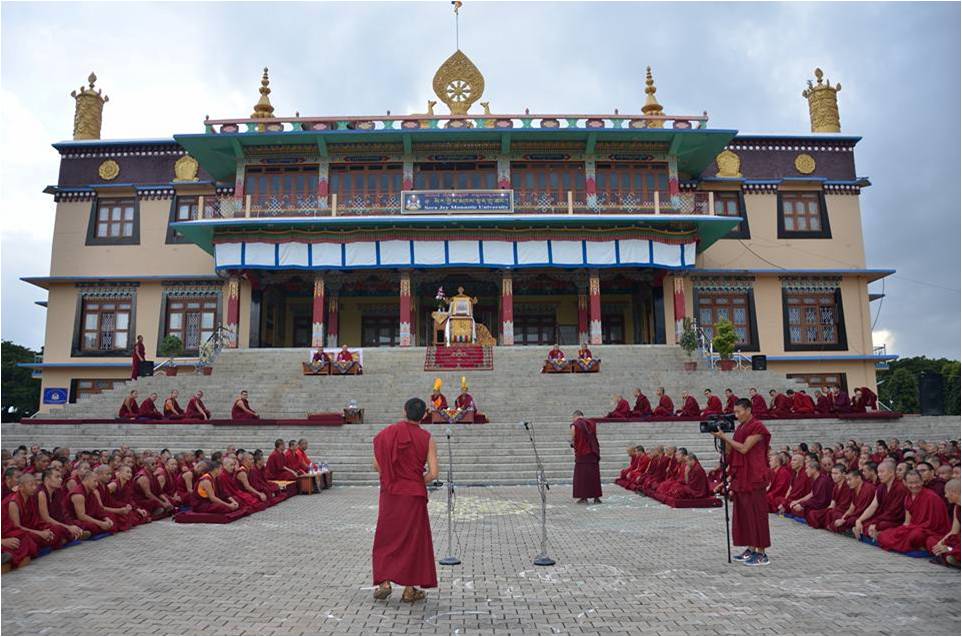 monastic discipline. The Gelugpa-school was founded by Tsong Khapa (1357-1419). He first founded the Ganden-monastery, so the school was principally called Gandenpa.
monastic discipline. The Gelugpa-school was founded by Tsong Khapa (1357-1419). He first founded the Ganden-monastery, so the school was principally called Gandenpa.
About Tsong Khapa many legends go around, but it is true that he was an important scholar and at the age of 32 he had already studied the most important Buddhist texts and he had started writing down how, to his opinion, Buddhism could best be interpreted and carried out. One of his most important ideas was that he put strong emphasis on a strict following of the rules, as written in the Dulwa (S. Vinaya). To him it was important that monks would study Buddhism and practice Tantra, without breaking the monastic rules.
In order to achieve all this, the Gelugpa-monasteries have a strict monastic system which is hierarchically organised and Sera is no exception to that. On the top of each monastery is the Abbot or Khenpo. Under him are several functions of which the Gegu (disciplinary monk), the Lobpon (head teacher) and the Umze (chant-master) are the most important. Although the children do not have real jobs yet, they do have to carry out certain tasks, for example, during pujas, they have to serve tea and food to everyone
More importantly Sera is set up in different groups. First of all the monastery is split into two parts: Sera Je and Sera Mey. Besides a slight difference in the texts they study, the split is moreover one to divide the enormous amount of monks into two groups. Then, each of these two parts is divided into khangtsens which consist of more or less the same structure as the monastery itself. They have their own head, their own Lobpon, Geku and Umze. Within the khangtsen there are the groups of students who all belong to the same teacher. Because of all these smaller departments the monastery is quite easy to control. In order to get one of these higher positions students have to follow an educational path, which can eventually lead to the Geshe-degree, the highest degree within Gelugpa-monasteries.
First they start at Sera Je Secondary School (SJS), where they learn Buddhist philosoply as well as modern subjects. After finishing the ten classes of SJS they can continue studying at the university. There they will study only the dharma and they will debate a lot. This course will take at least 20 years, after which they will do exam and receive one of the four levels of Geshe: Linsay, Rigram (BA), Tsogram (not successful enough for Lharampa, but still Master), Lharampa (PhD).
To get the highest Geshe-degree, one has to take 6 exams, which are competitions against the two other big monasteries, Drepung and Ganden. Reaching the Lharampa-level is extremely hard and only few very determined monks will get it. Once they receive the Geshe-degree (no matter what level), they are allowed to wear the special Geshe-shirt, which is not only dark-red, like the normal monks-shirts, but it has yellow on it, by which they will distinguish themselves.
Nevertheless only Lharampa-geshes can become Abbots. In order to receive the degrees and be a good monk, one has to live by the strict rules of the monastery and listen well to his teacher. Respect for the teacher is considered to be very important. Theoretically all (important) teachers can trace their roots back to the most important scholars of Buddhism. And since, in that way, they have directly received their teachings from important teachers as well, they will always show the greatest of respect to their own teacher, since they have already accumulated more wisdom then the students. After finishing the Sera Je University the monks can go to other monasteries to study Tantric practices. In other traditions of Tibetan Buddhism, monks will study these practices already during their regular studies, but the Gelugpas think that one can only study Tantrism after totally understanding the Dharma, otherwise things could go wrong.
The role of the Khangtsens
In order to structure the 4600 monks of Sera, there is a system of “region-houses”. Both Sera Je and Sera Mey consist of 17 Khangtsens. These are monks’ houses in which a group of monks from the same region live together. In Sera this means that, when a child arrives into the monastery, he is asked about the region where he comes from, or, more importantly, where is parents are from. Every Khangtsen then has its own Temple, its own Geku, and Head. The Khangtsen is then, besides the Shagen (a teacher who guides the child into the monastery and introduces it to the other monks) and his other students the first group a child-monk belongs to. Each Khangtsen is linked to a certain region in Tibet, or nowadays, to a region in India or another country. Besides the Tibetan Khangtsens in Sera there is even an International Khangtsen where Western monks can live.
This structure into houses does not only mean that the monks have smaller groups to identify themselves with, but it also helps a newly arrived child to adapt to his new situation a little faster. Most of the time, the child will see relatives or old neighbors in that Khangtsen again, because they all came from the same region, but more importantly, the child will be able to speak his own dialect.
But their individuality comes up especially when talking about the admission of children to the monastery and the assignment of a Shagen to the child. When a child enters the monastery, he first goes to the Khangtsen of his region. In most cases he will be taken there by his parents, or another relative who already knows the monastery. If this person is also a monk, then most probably he will be appointed as the Shagen of the child. If this is not the case, then, depending on the system of each khangtsen, there might be some sort of a lottery. All names of all monks who have finished Dulwa-class will be put in a bowl and the one that is being taken out will be the next shagen. Another system might be that all students, who have finished at least Dulwa-class are being put on a list and then the name on top will be the Shagen. Within this Khangtsen the child will live, which does not necessarily mean he will really live on the same ground as most of the rest of the monks, but it means he will belong to that Khangtsen and some of the activities he does as a monk, will be performed within that group (for example reciting religious texts).
Sera Je Secondary School (SJS)
It is a rather modern school, considering the fact that it belongs to a monastery. Because of that it is the only school that has an affiliation with the Indian School board. Besides Buddhist philosophical education, the students learn modern subjects as well.
- History of SJS and present situation
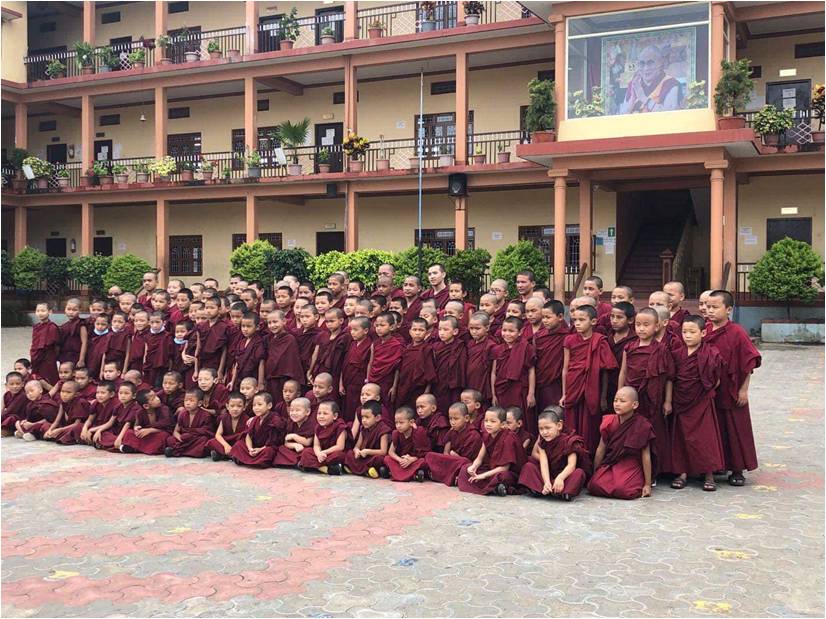 The school was founded in 1975, when a handful of monks was taught in Tibetan by a senior monk teacher. It was a part-time learning centre to which anyone could join regardless of age. In June 1984 SJS was restructured, due to a sudden increase of monks. Also many foreigners started visiting Sera, but no interpreter was present, because nobody could speak English, so there was a need for good education. SJS was first recognized by the state government as a charitable educational society. In 1996 the school was recognized as a monastic school which caters to the educational and social needs of novitiate children of the Tibetan community. By October 1997 the Central Board of Secondary education in Delhi recognized SJS as the first ever Tibetan monastic school of secondary level by granting the affiliation status. About 75% of the students of SJS continue their religious education at the university in order to receive their geshe-degrees. About 20% join other colleges and institutes for modern education and 5% drop out of formal studies. A very special thing about SJS is its strong connection to the West. Especially Australia is a great sponsor of SJS and the monks of Sera. Many Australian Buddhists send money every month to several children and senior monks and sometimes they even come to visit. The school has even got special rooms where the sponsors can stay during their visit.
The school was founded in 1975, when a handful of monks was taught in Tibetan by a senior monk teacher. It was a part-time learning centre to which anyone could join regardless of age. In June 1984 SJS was restructured, due to a sudden increase of monks. Also many foreigners started visiting Sera, but no interpreter was present, because nobody could speak English, so there was a need for good education. SJS was first recognized by the state government as a charitable educational society. In 1996 the school was recognized as a monastic school which caters to the educational and social needs of novitiate children of the Tibetan community. By October 1997 the Central Board of Secondary education in Delhi recognized SJS as the first ever Tibetan monastic school of secondary level by granting the affiliation status. About 75% of the students of SJS continue their religious education at the university in order to receive their geshe-degrees. About 20% join other colleges and institutes for modern education and 5% drop out of formal studies. A very special thing about SJS is its strong connection to the West. Especially Australia is a great sponsor of SJS and the monks of Sera. Many Australian Buddhists send money every month to several children and senior monks and sometimes they even come to visit. The school has even got special rooms where the sponsors can stay during their visit.
- Subjects at SJS and school-schedule
The students of SJS do not only study their religious texts, but they get a total modern education besides that as well. The subjects they take are: Performing arts, general science, mathematics, social studies, Tibetan calligraphy, Tibetan language and grammar, English and Hindi. From class VII on children start studying preliminary philosophical texts and they begin debating sessions. During the assembly for the school the children will say the mantra of Manjushri, the Bodhisattva of wisdom, in order to acquire the qualities to study well. Besides they will sing the Tibetan and Indian anthems. An average school day would then look like this:
06.30 Breakfast, memorization of religious texts and scriptures until 08.45
09.00 Morning assembly, speech and newspaper reading at SJS
09.15 – 10.30 Two periods with 15 minutes break
10.45 – 12.00 Two periods
12.00 – 14.00 Lunch break
14.00 – 15.20 Two periods with 15 minutes break
15.35 – 16.55 Two periods
17.00 – 18.00 Dinner
18.00 – 20.00 Recitation of scriptures and class assignments
LIFE OF KIDS IN MONASTERY
Age of entry to the monastery
Traditionally children who join the monastery were around the age of 7 or 8, some among them could enter at the younger age, the Tibetans or the people in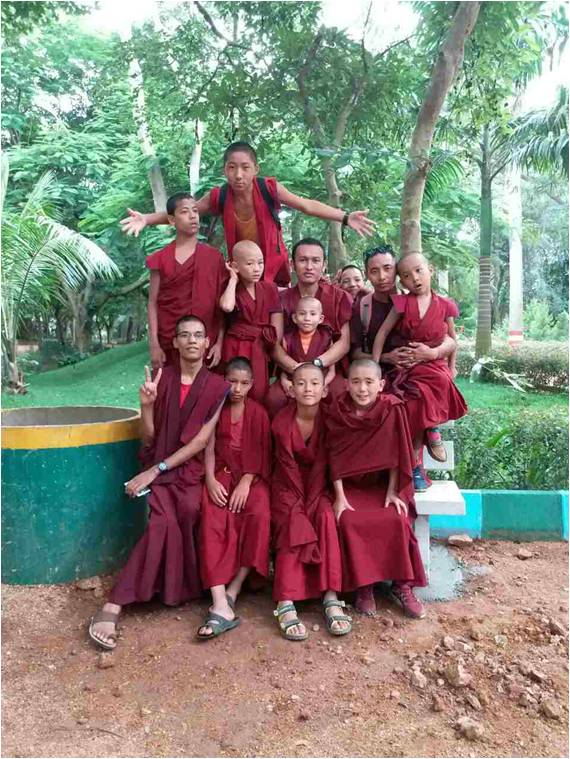 Himalayan regions seem to think that children should enter the monastery as young as possible. Much have seen that some of best scholars began as children.
Himalayan regions seem to think that children should enter the monastery as young as possible. Much have seen that some of best scholars began as children.
All children can enter the monastery, but some are less preferred or even refused. The ones who enter monkhood needed to be of a certain age, to have permission of their parents, to be free from certain diseases and physical deficiencies, not to be debtors, runaway slaves or army deserters and not to have committed crimes.
Reasons for entering the monastery
- The Tsung gral system.
This system ensured that parents would feel obligated to send one or more of their children to a monastery. Normally the oldest son would stay at home, to look after the parents, get married and continue the lineage. A second son could then be sent to the monastery.
- Religious reasons.
Although the reason described above seems very obligatory, the main reason for going to a monastery is a religious one. Parents, who send their child to a monastery or nunnery, believe that they will be reborn in a better state, or that their child will get a promising next life. Another religious reason to be found in the literature is when a child is ill, but gets better, the parents promise in their prayer to send that child to a monastery out of gratitude. But not only parents give in to these religious reasons, also children sometimes feel they were meant to go to the monastery. At the birth of baby, old people of high status pay attention to see if anything special happens around the time of birth. This should predict if the child has good potential in spirituality or not. If it happens that the child is a tulku, then the parents immediately give the child to the monastery.
- Religious consciousness of children.
The idea of a religious decision made by children, for example what we read above about children themselves deciding to go to the monastery because they feel some sort of “vocation”, is of course based on the assumption that children have a religious consciousness. They do have a sixth sense that makes them more sensitive to religion and with which children are much more sensitive to things than adults. This is the start of religious consciousness for a child, who, at least, does have an opinion about his religion and hence can make a decision about it.
- Economical reasons.
Besides the religious reasons parents might have to send their child to a monastery, because of financial shortcomings. Tibetan society used to have a patrilocal settling system for marriages. This made sure that parents did not only have to look after their own son, but also their daughter in law and their children. Because of this, boys more often than girls, were sent to a monastery. If a family had more than one daughter it was a heavy load to arrange marriages for all of them.
If a couple had many children it could also happen that they simply did not have enough money to take care of them all, thus they would send one or more of their children off to a monastery, where there would be taken care of them. When children lost their parents and their family did not want to take care of them, they were also sent to a monastery. Most of the time people preferred this to arranging a marriage and, in the case of a girl, paying a large dowry. The monasteries in Tibet were the only institutes where a child could get proper education, so for some people this was also a reason to send their child to a monastery.
- Socio-cultural reasons
In early Buddhism in India, people saw joining monastic life as the only escape from the lay-life they could not accept (because of the caste-system), or thought of it as an easy way of acquiring good food in return for little physical labour.
Especially girls seem to go to a nunnery out of free will, sometimes even against their parents’ wishes. These girls do not want a life full of obligations and so they seek the relative freedom of a nunnery. Another reason in this category was to accompany a brother, cousin or uncle, who had already joined the order.
- Ideological reasons
Since the annexation of Tibet by China there has come up an even more ideological reason for sending children to monasteries or nunneries. To preserve Tibetan culture and religion, parents find it extra important to do that by letting their children become monks or nuns.
Friends
Because the families and old friends of these children live far away from them, in addition, because they are not often allowed to go outside Sera, they can only make friends within the monastery. With these friends, they play all kinds of games. Some children, who come from Bylakuppe, are still in contact with their old friends, but just like their siblings, they only see them when they are allowed to visit their family. So these boys are, then, almost like brothers. They live together, have more or less the same background, study together, know the same people and behave in the same way. The child-monks act as if they were regular boys too, and in a way of course they are. They also like being mischievous or doing things they are not really supposed to do, or things that are not expected of them.
The initiation-ceremony
To become a real monk, a child has to be initiated by the abbot or another high lama. This happens in an official ceremony of which the exact time did not become clear from the literature. Still, this ceremony can be compared to the initiation-ceremony. There are three phases within an initiation ritual or “rite de passage” (transition ritual) as belows:
- Pre-liminal (separation): In the first phase, the child has arrived in the monastery and starts looking for a Shagen. In this first phase the child has already been separated from his family (especially the ones who come from far) and his social world in general.
The Shagens are the personal teachers of the children. The children live with their Shagen and this man looks after all their needs. It appeared that this person is the most important one in the lives of the children. Most of them loved talking about their “job” and the children they took care of. They were all some kind of father to the children.
- Liminal (transition): The second phase focuses on the official start of his life inside the monastery. Once the child has a teacher he will be checked for physical deviations, which could prevent him from being a proper monk. After that the initiation-ceremony can take place. As said before, there is some confusion about when this ceremony is supposed to take place.
There it says the child first has to be accepted to the method of the dharma and only after that he can be initiated. The teacher gives the child a new set of robes and takes him to the abbot. They take with them a khatag (a ceremonial scarf) and a pot of fresh tea. The novice then prostrates three times in front of the abbot. With this he does not only show his respect for the abbot, but he also demonstrates his physical condition. Then the abbot asks him if he wants to enter the religious life, to which the boy answers “yes”. Then the abbot cuts the last piece of hair as a sign of his breach with his profane life and his family. Then the novice gives a khatag to the abbot and someone else serves tea to the abbot and the novice. By drinking tea together the symbolic relationship between the abbot and the novice is confirmed.
- Post-liminal (incorporation):
Phase three is actually the phase in which the connection with the outer, or lay-world is being broken. It says that the child receives his monk’s robe directly. Also it says that his hair will be shaven except for one little piece on the top of the head. The abbot, during the initiation ceremony, cuts off this little piece. The child then also receives a different name. Only then he can start his study to become a drapa.
In short, the pre-liminal phase takes the child out of his normal surroundings, the liminal phase takes the child to the higher level of the initiation ceremony, after which he will reach the postliminal phase in which, on one hand he is incorporated as a monk into his monastic surroundings, on the other hand his new role will be incorporated into the lay-world as well.
For the child-nun, the organization in nunneries seems to be more or less the same as in monasteries. But what immediately catches the attention is the fact that there are far less nunneries than monasteries. And thus also less child-nuns than child-monks. An important difference that a nun, in order to be initiated she has to go to a monk, only a monk can initiate a nun.
The process of initiation
When children arrive in the monastery they are first accepted by a Khangtsen and they get a Shagen appointed to them. This shagen gives the child his new monks’ robe and often the child also receives one set from his parents. When this is all done, the Shagen is supposed to take the child to the Abbot, but most of them leave it to someone else. Only monks who have finished the Dulwa-class, the ones who are allowed to be Shagen, are allowed to take a child to the Abbot.
Besides, several children, at the same time can be initiated. In that way only one Shagen can take several novices to the Abbot at once. When the child has his new robe, his hair will be cut, leaving a little piece on the top of his head. When all this is done, he has to tell/ask the Abbot he wants to be a monk and he wants to study in Sera. An assistant of the Abbot will make an appointment with the Abbot for the child, which could be the same day or the next. Sometimes a child receives an auspicious date from the astrologer that he will be initiated on that day. When the Abbot is occupied that day, the child can be initiated by another high lama.
The Shagen or senior monk will then take the child to the Abbot on that day and they will bring, good tea, a nice khatag and an envelope with money. The quality of the tea symbolizes the qualities of the child to become a good monk. If the tea is good, the child will be a good monk. The khatag is offered to the abbot as a tradition that has been taken over from Tibet, probably as an expression of respect. The envelope with money which usually consists of 5 rupees represents the respect for the abbot and the religion.
The family can also offer something but only if they can really afford it. It does not happen very often though that the family offers something, mostly because they do not even know when the initiation is taking place. After the offerings, the tea is given to the attendant by the senior monk, after which the real initiation starts. It all takes place in the room of the Abbot. A completely new monk does 3 long prostrations in front of the abbot. The abbot can then see how the physical condition is of the child. The senior monk then also prostrates, but only the short way. The novice and the senior monk, sit down lower than the abbot out of respect for the abbot and their religion.
The Attendant then gives all three of them a cup of tea, to which the Abbot says he offers it all to the Buddha. Everyone then drinks the tea and gives the cup back to the Attendant. Then the Abbot starts asking questions to the senior monk and to the child.
The child is asked: From which part of India/Tibet are you? Were you already monk in Tibet? How is Tibet at the moment? How was your life in Tibet? How did you come to India? And most importantly: Do you really want to become a monk? The child has to answer these questions himself!
When the senior monk answers them, the Abbot will suspect that the child might not speak Tibetan properly or cannot speak at all. Then the abbot will take the little piece of hair and ask the final question: “Are you happy that you are now becoming a monk?” The child then has to answer “yes” and then the hair is cut. This is supposed to be the last check if it is really the child’s own wish to become a monk, but mostly it is not really voluntary what he says.
The child then receives a new name from the Abbot. This is his monk’s name and it is up to him whether he uses it or not. When the monk takes getsul or gelong vows he will receive another new name. Most of the monks continue using their lay-name, because everyone knows that one, but the gelong name is considered to be most valuable.
Before the child leaves the Abbot gives several advises to the child: Be a good monk; obey to the rules of the monastery; study well; respect all teachers and do not cause any conflicts in the community. These are all conditions to become a good monk. The senior monk will then ask permission to the Abbot if the child can be among other monks during pujas. He poses this request for the coming three years, after that, the child is supposed to be used to the monastic life, he will be following the discipline well and he will be studying himself.
After this ceremony the novice and the senior monk go to the gegu of the monastery and he will write down the name of the child in a book. Also with the gegu the child and the monk will have to stay lower than he. If he sits cross-legged, the child and the senior monk will have to squat, and when they stand, they have to be lower than he. After the gegu they go to the head of their khangtsen to whom they tell they have finished the whole process. The senior monk also asks, on behalf of the child if he can be treated in the same way as the other monks. The head gives the same advice as the abbot to the child and he writes down the name of the child in a book. As the last part of this process the child and senior monk will visit the head of the khangtsen kitchen, to whom they will ask if the novice can also receive the tea and food etc. just like the other monks.
The pre-liminal (first) phase will, in this case, consist of leaving the family, arriving to Sera and finding a Shagen. The liminal phase will start when the child receives his monk’s robe and when his hair is cut. However, he actually gets to the top of this liminal phase when the abbot cuts his last piece of hair, which is the definite separation from lay-life. Until the official cutting of the last piece of hair, the child is in-between layman ship and monkhood, he does not officially have a new role yet. The post-liminal phase will occur when the Shagen then takes the child to several senior monks in order to get the novice completely accepted. The child is then officially monk and accepted by the other monks and in his new role he will also be accepted by the lay-people.
The role of the Shagen
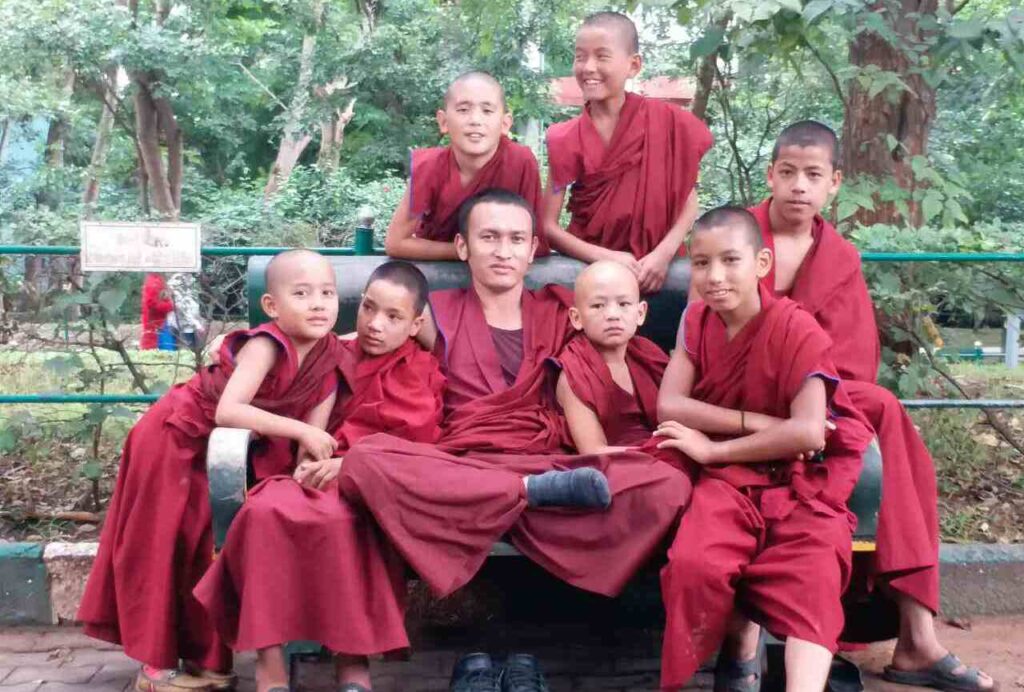 A child-monk in Sera, generally, lives far away from his parents. This means that there is hardly any parental influence on his life, besides maybe some good advise when they meet again. On top of that, there is no female influence at all in his monk’s life. All roles that normally play a part in a child’s life, mother, father, siblings, teachers, friends are now being carried out by monks. The most important role, therefore, plays his Shagen. A man cannot even be a monk, formally, if he does not have a Shagen. This Shagen then is really like a father to the children. He looks after their health, their pocket money and their progress in study. He has the greatest influence on the child, since he is the one who is closest to him.
A child-monk in Sera, generally, lives far away from his parents. This means that there is hardly any parental influence on his life, besides maybe some good advise when they meet again. On top of that, there is no female influence at all in his monk’s life. All roles that normally play a part in a child’s life, mother, father, siblings, teachers, friends are now being carried out by monks. The most important role, therefore, plays his Shagen. A man cannot even be a monk, formally, if he does not have a Shagen. This Shagen then is really like a father to the children. He looks after their health, their pocket money and their progress in study. He has the greatest influence on the child, since he is the one who is closest to him.
The life of the child-monk also greatly depends on the way the Shagen treats him. Some are very strict and will punish the child quickly when he does something wrong, others are more understanding and will treat the child more patiently. Just like strict or not-strict parents influence their children’s lives, so do these Shagens influence the lives of their students. It is important to know that a Shagen can have from 1 to hundreds of students at once. All of them live with him. An old monk can therefore have students who have already achieved their Geshes but also children who have just arrived to the monastery. One can say the Shagens have a great responsibility and through their father-role they become attached to the children, sincerely care about them and worry when they leave the compounds.
This attachment to the children, the responsibility and the time it takes to take care of the children is something that most Shagens dislike about their task. Most of them wish they had more time to study for themselves instead of worry about the children. Some also say that they feel guilty when a child does not meet the expectations of a parent. But most of them think it is very important that a child, at least, feels happy with his life. So if a child prefers to go to a normal school, they will let him go, but it depends on the Shagen how he will treat the child in that case.
The Gegu and discipline
There are several Gegus in Sera. The children have most contact with the gegu of their school, SJS. Of course there is also a gegu in their khangtsen and in the monastery, but the SJS-gegu is more than only a disciplinarian. He is also the counsellor. When children have problems with their study, the class or their teacher they can come to him and he will try to find a solution. Nevertheless he is also the one who will punish them when they have done something wrong, which of the time is physical punishment.
Teachers of the school are only allowed to “snap” the children when they disturb the class. If it really gets too bad they will call the gegu. Beating plays an important part in the way children experience their lives in the monastery. There are different types of beating:
- When children continue to behave badly he will undress the lower part of the child, in front of the other school-children and hit him with a stick. This is meant as a warning for other children.
- When the child still continues to disturb the classes he will be dismissed from the school and he cannot come back.
The SJS-gegu, though, not only disciplines the children by punishing them, he also gives presents when they do well. Also the gegens (religious teachers) use some kind of whip to make the children study harder. Since the respect for teachers is so big, children will hardly ever go against the punishment they get. They realize it is being done for their own good, but of course they still do not like it.
Source.
- Monique Jacqueline van Lochem. Children of Sera Je The life of children in a Tibetan Buddhist monastery and their opinion about that life. Master Thesis Leiden University Department of Cultural Anthropology, March 2004.
2. Website of Sera Jey Ngari Khangtsen. https://serajeyngari.org/

